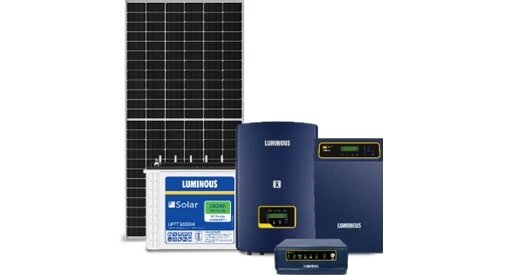More and more homes are adopting solar power systems as they are a cost-effective power solution. Along with the pockets of consumers, solar power systems also prove to be friendly to the environment.
If you are considering switching from traditional sources of energy to solar power, now is the right time to do so. But before you do that, you might want to understand how a solar power system works.
In this guide, we are going to discuss the basics of solar power systems. We will cover the key components of solar systems and how they work together to make a solar power system work.

Image Source: Luminous
The Inside of a Solar Power System
Every solar power system consists of a few key components that are responsible for the efficient working of the system. These components are:
- Solar Photovoltaic Panels
The most commonly known component of a solar power system is photovoltaic panels. The PV panels are responsible for capturing sunlight that is ultimately converted into electrical energy. Generally, solar panels are available in different sizes with different power capabilities. You can also wire multiple individual panels to make a larger solar array with higher capacity.
- Solar Power System Disconnects
A solar power system disconnect acts as an electrical switch to connect or disconnect the solar panels with DC power. It becomes useful when you have to repair the solar power system or make an adjustment to the solar panels. A solar power system disconnect is generally stronger than regular switches as it handles the whole power output from the solar panels.
- Batteries and Battery Charge Controller
A home solar system also requires a battery backup as the system cannot provide power during the night-time or cloudy days. The battery charge controller makes sure that the batteries are getting a controlled amount of electrical power; otherwise, the batteries might get overcharged.
- Solar Inverter
The solar panels generate DC current, while the electrical appliances use AC power. Hence, a solar power inverter is required to convert the DC solar energy into AC power. Trusted brands such as Luminous sell a wide range of solar inverters with different power capacities.
- Solar Power Meter
While a solar power system meter is optional, having it included in the system can be extremely beneficial as it shows how much solar power is being supplied to the home by the solar panels. It also helps in checking if the panels need maintenance by showing a drop in efficiency.
How Does a Solar Power System Work?
As we discussed above, solar panels capture the light coming from the sun. These are metal panel frames and glass casings with silicon installed in the metallic part. When the particles of light (scientifically known as photons) hit the silicon layer present on the top of solar panels, they push off the electrons from the silicon atoms.
This photovoltaic charge produces DC current that is captured by the wires present in the solar panels. This electric current is then converted from the DC form to the AC form with the help of a solar inverter. Electrical appliances such as fans, tube lights, and mobile charge consume the AC current from wall sockets, and this way, a solar power system runs a household.
Conclusion
In case you are looking for a robust solar energy system to power your household or business appliances, you can head to Luminous’ official website. With 7+ manufacturing units and 28+ sales offices in India, Luminous has been a leading solar solutions brand for the past 35 years.
Santosh Kumar is a Professional SEO and Blogger, With the help of this blog he is trying to share top 10 lists, facts, entertainment news from India and all around the world.
